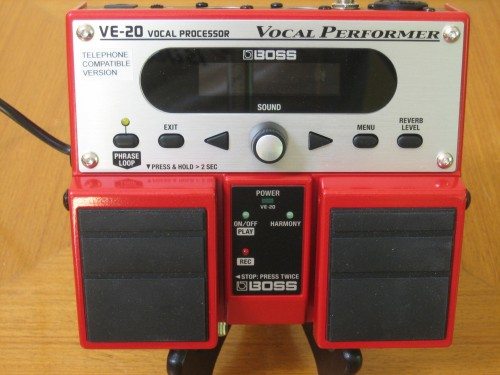
When I first discovered the Telephone Voice Transformer from Spy Gadgets, I thought it would be a fun gadget to have. While it does what it’s supposed to, I can’t find a practical use for the device. However, if you’re in law enforcement or a wannabe James Bond, this is for you.
The premise behind the Voice Changer is to change, in real-time, your voice so that’s it’s unrecognizable by the listener. It does this by not only changing the pitch, but several other sound parameters, giving a more natural sound than most voice changers. These changes can be done on the fly, or you can program a voice and save it for later use. Moving between an artificial voice and your natural voice is as simple as flipping a switch.
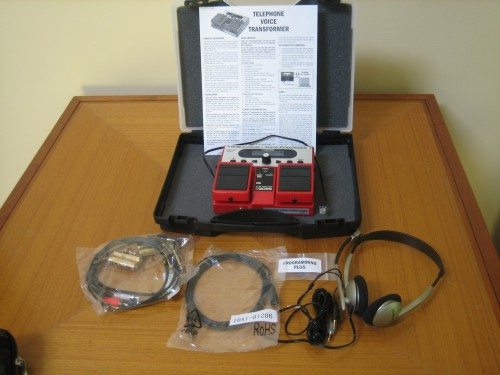
The package comes complete with the cables and accessories you need. The device itself is built ruggedly and looks like it will take some abuse. I’m sure some of you recognize this device. It’s a Boss Audio VE-20 Vocal Processor modified for the voice changer application. The good folks at Shomer-Tec include the VE-20 manual, so if you’re of the musical mind, you can use the unit for your vocals, but I’m limiting the review to voice changing application. In truth, you really don’t want to hear me sing 🙂
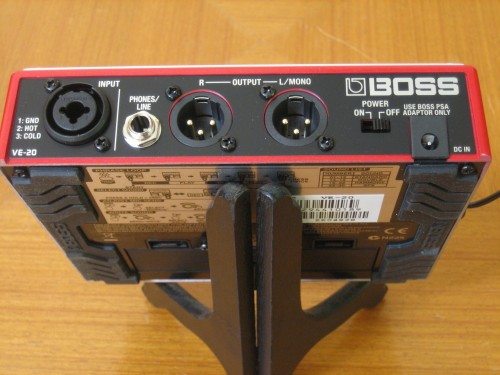
There’s a lot of connectors on the back, but only the power switch is used for the voice transformer.
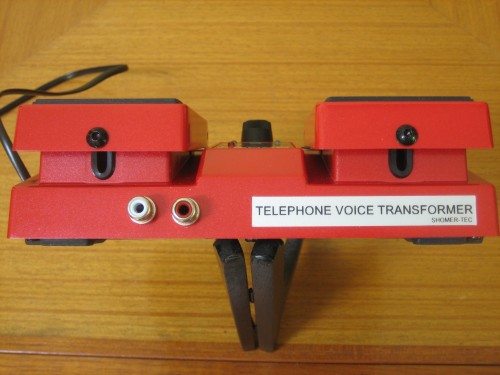
On the front there are the addition of audio output jacks.
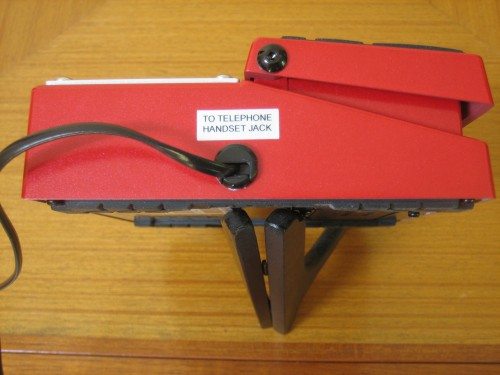
The left side has cord with a standard telephone plug at the end.
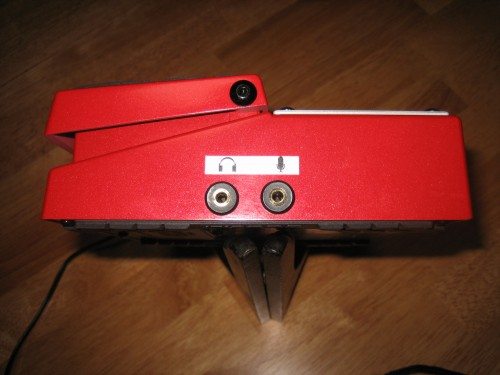
The right side has been modified with jacks for the included headset.
The Voice Transformer is configured to be used with a “standard” telephone. This means one needs a corded phone with a handset that plugs into the side of the telephone using a modular plug. The keypad dial cannot be in the handset. In other words, this device does not support cordless, dial-in-handsets or cell phones.However, according to the instruction sheet, a cell phone adapter in in development. Thankfully, there is also provision for connecting to a computer, so I was able make calls using Skype and Skype out. The requisite cables are provided.
After installing the batteries and reading the one page instructions, I was ready to create my first voice. This is a simple process and there are only two parameters that need be adjusted: GENDER and OCTAVE. I installed the “programing plug” on the end of the modular cord. This appears to be a loop back connector the allows one to hear the effects of creating the voice in the headset. I found it difficult to hear the modified voice via the earphones. It was overpowered by hearing my natural voice. What worked for me was to record the output using voice recorder on the PC and playing back the results.
The gender parameter can be adjusted between -10 and +10 with minus ten being the most male and plus ten being the most female. The other adjustment is an octave parameter that can raise and lower one octave. Adjusting the 2 parameters provides many different voices that can then be stored for later use. Obviously, different people will have different results dependent upon their voices, so if there are multiple users of the device storing voices is helpful.
I’ve provided some samples above of the voices I created using the extremes of the parameters. There are many more iterations possible and with patience I was able to get some that sounded almost normal. I say almost, because no matter what I did, there seemed to be a very slight mechanical flavor to the voices. That being said, I decided to call multiple people on Skype to see if I could fool them.
My first test was a call to my brother using Skype. I used a female voice expecting to fake him out, but he knew who it was by the Skype caller ID (duh!). After some small dialog, he did attest that the manufactured voice did sound reasonably normal. I told him I couldn’t come up with a practical use for the Voice Transformer and he suggested it would be great for crank calls. Great idea if I was in Junior High!
Next I placed a call to my wife, telling her to answer using Skype on her laptop. Due to a miscommunication (amazing, because this rarely happens between married couples), she thought I was transferring a call from someone else and didn’t realize it was me and my female voice. I then made Skype Out calls to landline phones to find out if that was also as natural sounding as web calls. It again passed a critical test from the multitude of people I called. Those that didn’t hang up on me, were impressed by the voice changing capability and didn’t know it was me.
Some final thoughts. This device is not a toy. It is marketed for use in law enforcement and military applications. There are an almost unlimited number of adjustments that can be made to the sound output, but are kept to a manageable minimum for the voice application. Also, if you’re musically inclined, because the hardware of the Voice Transformer is derived from a device for augmenting a singing voice, you too might get on American Idol. In my case, try as hard as I could, I wasn’t able to emulate the sounds of the late Roy Orbison. For the targeted market, the Voice Transformer merits serious consideration.
Apple iPhone 14 (Renewed), 128GB, Midnight - Unlocked
Samsung Galaxy A01 16GB BLACK VERIZON (Renewed)
$39.99 (as of 12/30/2025 18:11 GMT -06:00 - More infoProduct prices and availability are accurate as of the date/time indicated and are subject to change. Any price and availability information displayed on [relevant Amazon Site(s), as applicable] at the time of purchase will apply to the purchase of this product.)Product Information
| Price: | $549 |
| Retailer: | Spy Gadgets |
| Requirements: |
|
| Pros: |
|
| Cons: |
|



Gadgeteer Comment Policy - Please read before commenting
Holy crap, Spy Gadgets, wants $550 for this thing. From virtual any music store, the same device is $250! $300 for the privilege of calling a music effects processor a “spy gadget”.
Hi Bill,
thanks for the cool review! I bought this device at the beginning of this year, not for this application 🙂 but it’s interesitng and I’m eager to know which settings you are changing exactly? Any chance you can forward the manual? You should have my e-mail. Tx!
@Kris
I sent you the manual via PM. There are only two settings that were changed to get the different voices: gender and octave. The device has other parameters that can be adjusted, but that was not covered in the one page manual.
Thx Bill, I’ll play around and see if I can put some voices online as well. Let the fun begin!
Thanks for the review
Is this an older or newer version of the Boss VT-1 Executive Professional Voice Changer?
http://www.brickhousesecurity.com/vc-vt.html
And how does this compare to the BOSS VT-1?
The BOSS VT-1 which is no longer in production seems to have more slider controls & buttons overall..
John,
I’m not familiar with the VT-1. The review unit was the latest version from the provider. As to your first post, you are welcome.
Bill
hi,
i’ve tried to use it with skype. but the voice has a very very low level, noone is able to hear. and there are some noise in backgroud.
i’ve tried to record the voice, and it’s ok.
i’ve tried with the call-test in skype and everything is fine, but if i make a call the other one can’t hear me at all.
could you help me?
Johm
Johm,
Don’t know what to tell you. I used it both with Skype to Skype and Skype out with no problem. Try different ways: have someone call you, go Skype out and you could also do Google Voice via Gmail. If it works with Skype call test, it would seem the device is OK.
Bill
Hi Bill,
thanks for your quickly answer, after i’ll upload some sample so you can hear it and (i hope) give me some suggestion.
i make a call with skype to a mobile, maybe the problem is in this, or in my bandwidth.
any idea is appreciated.
bye
Hi, Bill.
How exactly do you connect this device to the computer for use with Skype? I looked at the photos you have in this very informative article, but couldn’t quite work out where the adapter you referenced plugs in.
I have an iMac–do I need to use a PC?
Daniel,
From the instructions:
1. Connect the included RCA cable adapter between the two RCA jacks on the front of the Voice Transformer and your computer’s AUDIO IN jacks.
2. Connect the headset’s earphones cord to your computer’s AUDIO OUT jack.
3. Connect the headset’s microphone cord into the microphone jackk on the right side of the Telphone Voice Transformer.
This should work with an iMac.
Hi Bill,
thanks for the review! I ‘ got one of these and would like to see if I could modify it, as it seems i’m not cut out for singing! Any chance you can forward the manual? Thanks.
Barry,
I just gave it away. BTW, the manual for the voice changer was one page. It didn’t detail the modifications.
I would love to have a scanned copy of the manual? I’ll reverse
engineer the product, and save your readers a few hundred dollars.
Spygadgets are essentially ripping off Boss, and honestly don’t need
financial gain. If I get a copy of the manual, I’ll do my best to
send you a copy of the electronic schematic diagram.
Thanks for the post!
The manual is copywritten. To the other person that asked, I only sent the operating instructions, but incorrectly called it the manual.
I have this device…I have tried to set it up with 3 different phones. All the phones are standard desk telephones, but I can’t get a dial tone when I plug in everything correctly and lift the receiver to get the dial tone. I have redone the directions and everything else is correct… Any suggestions?
Beth,
I suggest that you give the company a call. Make sure you are connecting the handset of the phone to the device and then the device to the base of the phone. Be aware that if your handset has the buttons in it, it won’t work.
Hi
It’s John from August 27, 2010 at 5:09 pm again..
Quick qn – how easy would it be to reverse engineer the voice changing function from the basic Boss gadget from which it is derived?
Ha! I love it. It’s true, voice changing isn’t for everybody…it’s kind of this fringe thing that some people really get into, and even fewer people can really make it work for the amusement of others (and not just themselves…not that there’s anything wrong with that!). Then again, Google shows that the term “voice changer” is far more searched for in Pakistan, so maybe that’s where sales come from?
http://www.google.com/insights/search/#q=voice%20changer&cmpt=q
Anyways, I continue to be shocked at the price these hardware-only devices are asking. $550!!? We looked at this unit as well as the VT1. The VT1 is really impressive, but for the cost, I think the software voice changers out there have way more options and flexibility. Of course, software is limited in a few ways too. But that’s why we made the exVox: to combine the limitless possibility of software voice changers with the flexibility and I/O usability of hardware. But I digress…
Though voice changing may not be the most popular past-time in the world, I guess those that want it, are ready to pay for it…?…maybe not….
Thanks for the info!
Can Telephone voice changer VE-20 work with mobile phones too?
Sohail,
Probably not. I can’t see a way to connect it to the cell phone.
Is this voice transformer sold to the general public?
Charles,
It was 5 years ago, but I don’t think it’s available anymore.
The upgraded version is available and does work with smart phones. The device IS expensive but it’s the only one on the market that actually works. The price of the device is what it is. As with any other business we have to make a profit to keep the doors open but I can assure you that we aren’t getting rich selling voice changers.
http://www.spygadgets.com/professional-telephone-voice-changer/